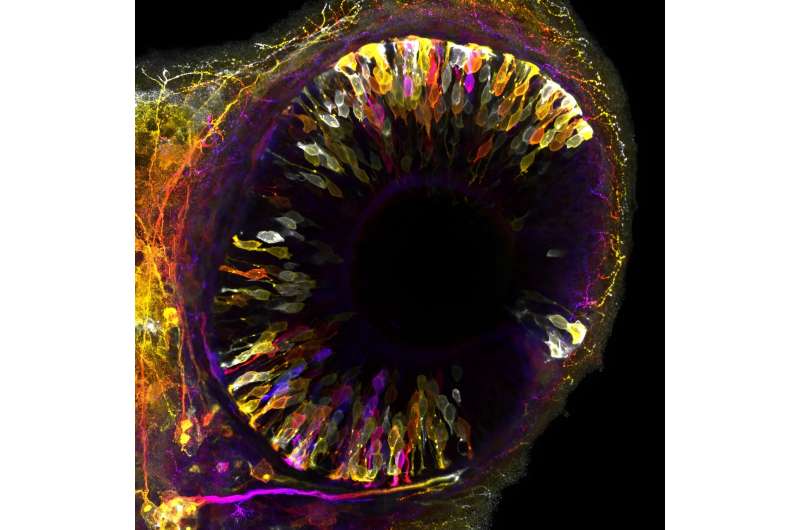This article has been reviewed according to Science X's editorial process and policies. Editors have highlighted the following attributes while ensuring the content's credibility:
fact-checked
peer-reviewed publication
trusted source
proofread
Neuronal migration: How neurons make room for growth in a developing organ

Researchers at the Instituto Gulbenkian de Ciência (IGC, Oeiras) and Max Planck Institute of Cell Biology and Genetics (MPI-CBG, Dresden) identified a new mechanism that exposes some of the multitasking abilities embryos need to build a functional retina.
The discovery, published in Nature, provides an important contribution to understanding how healthy organs are built, which is ultimately critical for understanding how organ malformations, that affect 8 million newborns every year, arise.
To function properly, organs require a precise number of cells and a functional architecture, which are established during embryogenesis. Embryos are proficient multitaskers; they grow, and acquire shape and functional architecture all at once.
Despite much research on embryo development, scientists do not yet fully grasp how embryos orchestrate all these different tasks in space and time to ensure the formation of healthy organs. This was the central question of the study led by Caren Norden (group leader) and MauricioRocha-Martins (postdoctoral researcher). The research team, that also involved computer scientists, used cutting-edge technology to explore how the vertebrate retina copes with the challenges of growing profusely while, at the same time, remodeling tissue architecture.
The retina of zebrafish embryos and human retinal organoids—mini retina-like structures in a dish grown from human cells—were used as model systems because they both offer unique advantages due to their small size and high translucency, allowing real-time observation of tissue organization and growth. Advanced microscopy techniques, such as light-sheet microscopy and state-of-the-art image restoration based on deep learning, provided unprecedented insight into the cellular behaviors involved.
The researchers observed that an entire population of neurons, photoreceptors, temporarily relocates away from the zone of the tissue where they reside and must fulfill their function. This active movement creates space for incoming progenitor cells that divide in this area and thereby produce more cells that later contribute to the neuronal retina.
Blockage of the movements of photoreceptors leads to congestion, forcing progenitor cells to divide in wrong place which in turn causes tissue malformation. Thus, by transiently moving away, neurons avoid interference with progenitor cells to ensure harmonious organ development.
To Mauricio Rocha-Martins, the first author of the study, "This is a curious migration phenomenon, in which neurons move away just to then move back, ending up where they started. It highlights that neuronal migration, as opposed to what was previously believed, does not only move neurons to their correct location but can also play a direct role in the coordination of organ development."
The implications of this research extend beyond the field of retinal development. Simultaneous growth and acquisition of functional architecture is a hallmark of most developing organs; the new findings offer the possibility to investigate whether other developing organs employ similar strategies.
Moreover, it is known that defects in neuronal migration can cause severe brain malformations in humans. The findings that failed migration of neurons can have deleterious consequences beyond the positioning of neurons points to the importance of examining the interactions between cells to fully understand the causes of human developmental disorders.
More information: Caren Norden, Neuronal migration prevents spatial competition in retinal morphogenesis, Nature (2023). DOI: 10.1038/s41586-023-06392-y. www.nature.com/articles/s41586-023-06392-y





















